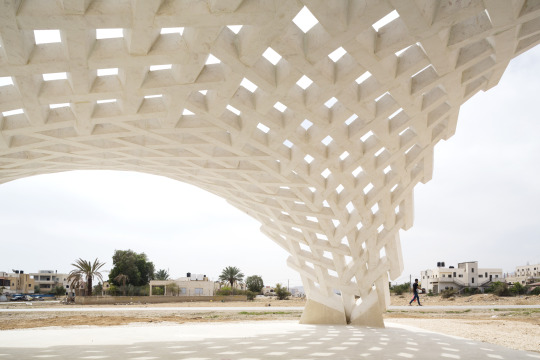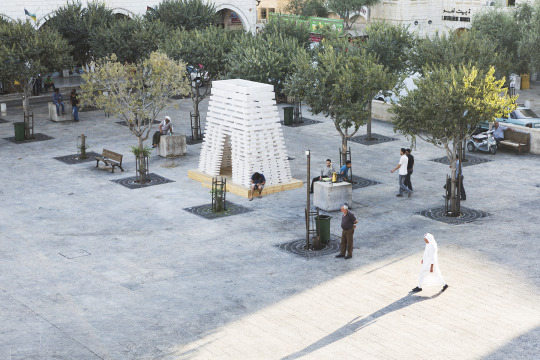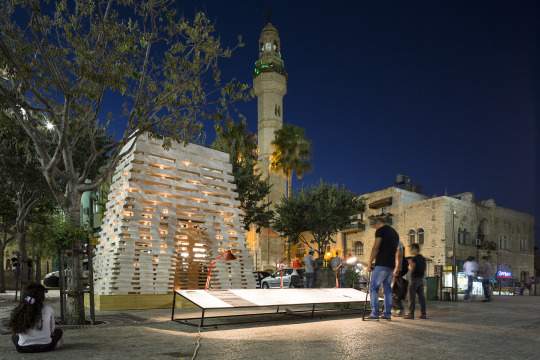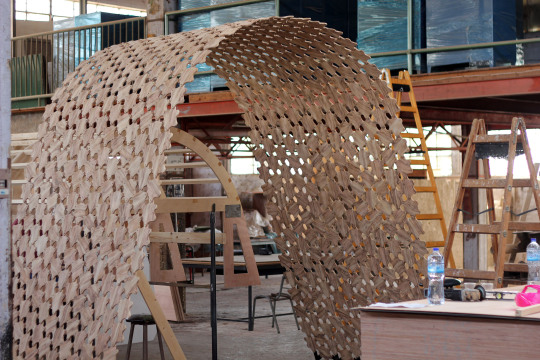#the lead up to the simulation was weeks of material about the historical context and political theory about
Text
Designing a Palestinian Sense of Place

Elias Anastas and Yousef Anastas in conversation
Bethlaham-based architecture and design studio AAU ANASTAS is a family affair. The practice is vastly diverse, from architectural experimentation to metal furniture to working with artisans on reimagining the materiality of Palestinian structures. I’ve asked Elias and Yousef Anastas to speak about design and place-making in contemporary Palestine.
Elias: The traditions of the Palestinian city, from social systems to the type of housing, are built around nature. The nodal point of the city, where people live, is concentrated and withdrawn but gives way to open landscapes. But this direct relationship with nature has been subverted, first under the Ottoman Empire and now during the conflict with Israel.
Yousef: Before and during the Ottoman Empire, urban development was influenced by three factors: harrat (“big families” to which every inhabitant is linked); hosh (a common shared space in the heart of a series of houses); and the typical city surroundings of olive orchards and terraced landscapes. At that time, urban strategies were regulated between the moukhtar, or chief, of each ¬harrat.
E: This self-managed urbanism – which matches many of today’s western criteria of a successful city – has been progressively disappearing. The dense nucleus is no longer as much a centre of interest as the surroundings, where cities boom. The British mandate put in place urban planning. Power rather than nature took precedence. Palestinian cities today have very complex boundaries. The Oslo agreement, the Israeli settlements, the barrier and wall separating Israel from the West Bank and excess urbanism have disrupted the traditional model. The process is a vicious circle: the settlements break up Palestinian lands and are linked to Israeli territory by bypass routes.
Y: In response, Palestinian cities have broken with their domestic scale, and the wall is dictating their boundaries. The unstable political situation leads to a lack of trust in public space. We had an opportunity to address the question of public space in the city of Bethlehem.


E: Our architectural practice’s design for the Edward Said National Music Conservatory plays on the hosh, aided by the development of a commercial project on a neighbouring plot. We battled to extend the space into a public pedestrian thoroughfare. The result is an area that embodies urban social power and artisanal skills, and helps build an inclusive city.
Y: Also in Bethlehem, we have built an experimental stone pavilion, Stonesourcing Space, which adapts traditional techniques. Ottoman laws transformed the use of stone from a natural choice to an imposed material for everything. This law is still applied despite the almost universal use of reinforced concrete in construction –but stone has been relegated to a cladding, a top dressing to satisfy an obsolete law. The pavilion combines stone, and its virtues in thermal efficiency and plentiful supply, with innovative technologies. The building – a contemporary interpretation of the mountar, a traditional shelter found in the Palestinian countryside – aims to mark property as an act of resistance to the path of the wall.
E: Most recently we completed a prototype of an on going research project on the use of three-dimensional free-form stone vaults in Palestine.
Y: The research aims at including stone stereotomy – the processes of cutting stones – construction processes in contemporary architecture. It relies on novel computational simulation and fabrication techniques in order to present a modern stone construction technique as part of a local and global architectural language.



E: The research highlighted the use of stone vaults in Palestinian architecture. Unlike neighbouring countries – like Lebanon or Syria – where stone vaults were reserved to noble monuments, stone vaults in Palestine are part of a common architectural language. As such, stone vaults are manifold widespread, yet more difficult to notice and identify.
Y: The results of the research will be used to build the el-Atlal artists’ and writers’ residency in Jericho. As such, a Stone matter is the first module of the residency and the first built vault of our research. A Stone matter is built on an innovative construction principal allowing for unprecedented forms for such structures. The architectural innovation is born from structural morphology and stereotomy. The whole structure is made of 300 mutually supported unique stone pieces.
Beyond the scientific and technical issues that make Stonematters a unique object, the project represents as well a cultural challenge: it has been entirely built with available know-hows in a peripheral zone of the culturally marginal city of Jericho.


E: Through the understanding of our historical cities the research tries to link techniques of constructions to urban morphologies. It puts a non-hierarchical hypothetical link between the scale of stereotomy and the scale of urban fabric. In that context, the idea is to suggest new urban morphologies linked to the scientific use of a largely available material in Palestine.
Y: We are interested through our work to link scales: Whether the impact of a construction technique on the formation of cities, or subverting artisans knowhow to new uses. “Mass Imperfections” is the 2016 Palestinian Pavilion commissioned by Dubai Design Week. The project investigated the ability of craftsmanship of stepping back into the forefront of the fabrication processes. The project challenges high tech fabrication processes by monitoring and anticipating imperfections of highly skilled artisans.
31 notes
·
View notes
Text
China Accelerates Next-Gen Nuclear Weapons Development To Compete With US, Russia
New Post has been published on http://foursprout.com/wealth/china-accelerates-next-gen-nuclear-weapons-development-to-compete-with-us-russia/
China Accelerates Next-Gen Nuclear Weapons Development To Compete With US, Russia
As we have been documenting over the last year and beyond, China is rapidly modernizing its military; unveiling a new stealth bomber, an array of guided-weapons, and deploying further from home. Their most recent focus has been on next generation nuclear weapons – as Beijing ramps up blast experiments for nukes comprised of smaller, smarter warheads designed to limit damage by targeting specific targets, according to the South China Morning Post.
Between September 2014 and last December, China carried out around 200 laboratory experiments to simulate the extreme physics of a nuclear blast, the China Academy of Engineering Physics reported in a document released by the government earlier this year and reviewed by the South China Morning Post this month.
In comparison, the US carried out only 50 such tests between 2012 and 2017 – or about 10 a year – according to the Lawrence Livermore National Laboratory. –SCMP
China’s development of next gen nukes will put them in direct competition with the United States and Russia, sparking concerns by experts over the prospect of a new cold war arms race that has the potential of boiling over into thermonuclear war.
Of primary concern is the notion that nations possessing smaller, targeted nukes might be more inclined to use them vs. larger and more devastating munitions – which could easily lead down the slippery slope of larger nuclear exchanges.
These new weapons are considered more “usable” for tactical tasks such as destroying an underground bunker while generating little radioactive fallout.
Pentagon officials have said the US wants its enemies to believe it might actually use its new-generation weapons, such as smaller, smarter tactical warheads designed to limit damage by destroying only specific targets.
But with these relatively safer and less destructive weapons in hand, governments may end up losing the inhibition to use them. -SCMP
“The use of small warheads will lead to the use of bigger ones,” Beijing-based naval expert Li Jie told the Post. “If other countries use nuclear weapons on us, we have to retaliate. This is probably why there is research to develop new weapons.”
While an international ban prohibits China from testing actual nuclear weapons (a ban North Korea has laughed at for years), major nuclear powers continue to conduct testing via high-powered gas guns that fire high speed projectiles at weapons-grade laboratory materials.
The tests are conducted using a large, sophisticated facility known as a multi-stage gas gun, which simulates the extreme heat, pressure and shock waves produced in a real nuclear blast.
The experiments with the gas gun provide scientists with the data they need to develop more advanced nuclear weapons.
In the past, researchers used supercomputers to draw on historic data derived from live nuclear tests performed before the international ban was imposed in the 1990s.
But new technology that emerged in recent years, such as hypersonic vehicles and artificial intelligence, opened the door for the development of new nuclear weapons that could be smaller in size and more precise.
The gas gun works by using special explosives to force a piston along a hydrogen-filled metal tube. Once the hydrogen gas reaches a certain temperature and pressure, an “impactor” is released which travels at incredibly high speeds of at least 18,640 MPH towards a target.
Smaller than a saucer, the impactor is comprised of the same materials used in a nuclear warhead such as plutonium, metal, plastic or foam of different densities – resulting in a chemical reaction similar to that of a nuclear detonation.
[insert: gas gun.JPG, f29bb5ca-5f25-11e8-a4de-9f5e0e4dd719_972x_130850.jpg , f2cf81f2-5f25-11e8-a4de-9f5e0e4dd719_972x_130850.jpg ]
US gas gun at Jasper facility in Nevada
The impactors are quite difficult to produce, as even the slightest structural defect at the microscopic level of just a few nanometers can ruin the experiment, according to Luo Guoqiang of China’s Minyang research center.
“The making of the impactor involves the cream of precision manufacturing. Thanks to numerous breakthroughs in recent years we are now beating our counterparts in the US with a series of impactors with superior performance,” he said.
Well made impactors, allow experiments to proceed faster at lower cost, while obtaining higher quality data.
Over the past three years, Chinese scientists have carried out more such gas gun tests than the United States has in 15 years.
In tunnels deep under mountains in Mianyang, southwestern Sichuan province, where China’s main nuclear design facilities are based, loud blasts from these experiments can be heard more than once a week.
In comparison, between 2003 and 2017, the US fired a total of 150 simulated shots at its Joint Actinide Shock Physics Experimental Research (Jasper) facility at the Nevada National Security Site. -SCMP
That said, China can’t hold a candle to the United States when it comes to advanced nuclear technology, according to Professor Wang Chuanbin, from the State Key Laboratory of Advanced Technology for Materials Synthesis and Processing at the Wuhan University of Technology.
Wang says that the number of live tests conducted by China pales in comparison with the U.S., which has set off over 1,000 nuclear warheads since 1945 beginning with the Manhattan Project. China, meanwhile, has only carried out 45 live tests.
“It is possible we are in a hurry to catch up,” Wang said.
James Lewis, senior vice-president at the Centre for Strategic and International Studies, a Washington-based think tank, said a new round of the nuclear arms race had already begun, though public opinion had yet to catch up with the grim reality.
The White House is considering a US$1.2 trillion plan to upgrade its nuclear stockpile. Earlier this year, the Pentagon announced it would develop new low-yield nuclear weapons that could be mounted on conventional cruise missiles and launched by submarines.
The White House’s developments are in response to Russia’s recent actions, according to Lewis, who notes that Russian President Vladimir Putin has revealed a series of new nuclear weapon designs – including smaller, tactical nukes – as well as a “super torpedo” capable of wiping out coastal cities.
“It’s not clear to me how successful the Russian programme will be, but it has stirred everyone up on the subject,” Lewis said. “After some debate, the US decided it needed to think about warheads, without the need for actual tests. It wouldn’t surprise me if China saw all this and decided that it had better get in the game.”
Following a February announcement by US officials of a new nuclear weapons policy, an editorial was published in Chinese state-run tabloid Global Times which said that China would seriously consider going public with its tactical, low-yield nuclear weapons program in response.
“China is a nation capable of massively increasing the size and improving the technology of its nuclear stockpiles,” stated the newspaper, adding “China needs a new policy to deal with a new situation.”
And as we mentioned last week, Bank of America’s Mike Hartnett writes that the “trade war” of 2018 should be recognized for what it really is: the first stage of a new arms race between the US & China to reach national superiority in technology over the longer-term via Quantum Computing, Artificial Intelligence, Hypersonic Warplanes, Electronic Vehicles, Robotics, and Cyber-Security.
At the end of the day, the China First strategy will be met head-on by an America First strategy. Hence the “arms race” in tech spending which in both countries is intimately linked with defense spending. Note military spending by the US and China is forecast by the IMF to rise substantially in coming decades, but the stunner is that by 2050, China is set to overtake the US, spending $4tn on its military while the US is $1 trillion less, or $3tn.
This means that some time around 2038, roughly two decades from now, China will surpass the US in military spending, and become the world’s dominant superpower not only in population and economic growth – China is set to overtake the US economy by no later than 2032 – but in military strength and global influence as well.
And, as Thucydides Trap clearly lays out, that kind of unprecedented superpower transition – one in which the world’s reserve currency moves from state A to state B – always takes place in the context of a war.
Which explains BofA’s long-term strategic recommendation: “We believe investors should thus own global defense, tech & cybersecurity stocks, particularly companies seen as “national security champions” over the next 10-years.“
0 notes
Text
China Accelerates Next-Gen Nuclear Weapons Development To Compete With US, Russia
New Post has been published on http://foursprout.com/wealth/china-accelerates-next-gen-nuclear-weapons-development-to-compete-with-us-russia/
China Accelerates Next-Gen Nuclear Weapons Development To Compete With US, Russia
As we have been documenting over the last year and beyond, China is rapidly modernizing its military; unveiling a new stealth bomber, an array of guided-weapons, and deploying further from home. Their most recent focus has been on next generation nuclear weapons – as Beijing ramps up blast experiments for nukes comprised of smaller, smarter warheads designed to limit damage by targeting specific targets, according to the South China Morning Post.
Between September 2014 and last December, China carried out around 200 laboratory experiments to simulate the extreme physics of a nuclear blast, the China Academy of Engineering Physics reported in a document released by the government earlier this year and reviewed by the South China Morning Post this month.
In comparison, the US carried out only 50 such tests between 2012 and 2017 – or about 10 a year – according to the Lawrence Livermore National Laboratory. –SCMP
China’s development of next gen nukes will put them in direct competition with the United States and Russia, sparking concerns by experts over the prospect of a new cold war arms race that has the potential of boiling over into thermonuclear war.
Of primary concern is the notion that nations possessing smaller, targeted nukes might be more inclined to use them vs. larger and more devastating munitions – which could easily lead down the slippery slope of larger nuclear exchanges.
These new weapons are considered more “usable” for tactical tasks such as destroying an underground bunker while generating little radioactive fallout.
Pentagon officials have said the US wants its enemies to believe it might actually use its new-generation weapons, such as smaller, smarter tactical warheads designed to limit damage by destroying only specific targets.
But with these relatively safer and less destructive weapons in hand, governments may end up losing the inhibition to use them. -SCMP
“The use of small warheads will lead to the use of bigger ones,” Beijing-based naval expert Li Jie told the Post. “If other countries use nuclear weapons on us, we have to retaliate. This is probably why there is research to develop new weapons.”
While an international ban prohibits China from testing actual nuclear weapons (a ban North Korea has laughed at for years), major nuclear powers continue to conduct testing via high-powered gas guns that fire high speed projectiles at weapons-grade laboratory materials.
The tests are conducted using a large, sophisticated facility known as a multi-stage gas gun, which simulates the extreme heat, pressure and shock waves produced in a real nuclear blast.
The experiments with the gas gun provide scientists with the data they need to develop more advanced nuclear weapons.
In the past, researchers used supercomputers to draw on historic data derived from live nuclear tests performed before the international ban was imposed in the 1990s.
But new technology that emerged in recent years, such as hypersonic vehicles and artificial intelligence, opened the door for the development of new nuclear weapons that could be smaller in size and more precise.
The gas gun works by using special explosives to force a piston along a hydrogen-filled metal tube. Once the hydrogen gas reaches a certain temperature and pressure, an “impactor” is released which travels at incredibly high speeds of at least 18,640 MPH towards a target.
Smaller than a saucer, the impactor is comprised of the same materials used in a nuclear warhead such as plutonium, metal, plastic or foam of different densities – resulting in a chemical reaction similar to that of a nuclear detonation.
[insert: gas gun.JPG, f29bb5ca-5f25-11e8-a4de-9f5e0e4dd719_972x_130850.jpg , f2cf81f2-5f25-11e8-a4de-9f5e0e4dd719_972x_130850.jpg ]
US gas gun at Jasper facility in Nevada
The impactors are quite difficult to produce, as even the slightest structural defect at the microscopic level of just a few nanometers can ruin the experiment, according to Luo Guoqiang of China’s Minyang research center.
“The making of the impactor involves the cream of precision manufacturing. Thanks to numerous breakthroughs in recent years we are now beating our counterparts in the US with a series of impactors with superior performance,” he said.
Well made impactors, allow experiments to proceed faster at lower cost, while obtaining higher quality data.
Over the past three years, Chinese scientists have carried out more such gas gun tests than the United States has in 15 years.
In tunnels deep under mountains in Mianyang, southwestern Sichuan province, where China’s main nuclear design facilities are based, loud blasts from these experiments can be heard more than once a week.
In comparison, between 2003 and 2017, the US fired a total of 150 simulated shots at its Joint Actinide Shock Physics Experimental Research (Jasper) facility at the Nevada National Security Site. -SCMP
That said, China can’t hold a candle to the United States when it comes to advanced nuclear technology, according to Professor Wang Chuanbin, from the State Key Laboratory of Advanced Technology for Materials Synthesis and Processing at the Wuhan University of Technology.
Wang says that the number of live tests conducted by China pales in comparison with the U.S., which has set off over 1,000 nuclear warheads since 1945 beginning with the Manhattan Project. China, meanwhile, has only carried out 45 live tests.
“It is possible we are in a hurry to catch up,” Wang said.
James Lewis, senior vice-president at the Centre for Strategic and International Studies, a Washington-based think tank, said a new round of the nuclear arms race had already begun, though public opinion had yet to catch up with the grim reality.
The White House is considering a US$1.2 trillion plan to upgrade its nuclear stockpile. Earlier this year, the Pentagon announced it would develop new low-yield nuclear weapons that could be mounted on conventional cruise missiles and launched by submarines.
The White House’s developments are in response to Russia’s recent actions, according to Lewis, who notes that Russian President Vladimir Putin has revealed a series of new nuclear weapon designs – including smaller, tactical nukes – as well as a “super torpedo” capable of wiping out coastal cities.
“It’s not clear to me how successful the Russian programme will be, but it has stirred everyone up on the subject,” Lewis said. “After some debate, the US decided it needed to think about warheads, without the need for actual tests. It wouldn’t surprise me if China saw all this and decided that it had better get in the game.”
Following a February announcement by US officials of a new nuclear weapons policy, an editorial was published in Chinese state-run tabloid Global Times which said that China would seriously consider going public with its tactical, low-yield nuclear weapons program in response.
“China is a nation capable of massively increasing the size and improving the technology of its nuclear stockpiles,” stated the newspaper, adding “China needs a new policy to deal with a new situation.”
And as we mentioned last week, Bank of America’s Mike Hartnett writes that the “trade war” of 2018 should be recognized for what it really is: the first stage of a new arms race between the US & China to reach national superiority in technology over the longer-term via Quantum Computing, Artificial Intelligence, Hypersonic Warplanes, Electronic Vehicles, Robotics, and Cyber-Security.
At the end of the day, the China First strategy will be met head-on by an America First strategy. Hence the “arms race” in tech spending which in both countries is intimately linked with defense spending. Note military spending by the US and China is forecast by the IMF to rise substantially in coming decades, but the stunner is that by 2050, China is set to overtake the US, spending $4tn on its military while the US is $1 trillion less, or $3tn.
This means that some time around 2038, roughly two decades from now, China will surpass the US in military spending, and become the world’s dominant superpower not only in population and economic growth – China is set to overtake the US economy by no later than 2032 – but in military strength and global influence as well.
And, as Thucydides Trap clearly lays out, that kind of unprecedented superpower transition – one in which the world’s reserve currency moves from state A to state B – always takes place in the context of a war.
Which explains BofA’s long-term strategic recommendation: “We believe investors should thus own global defense, tech & cybersecurity stocks, particularly companies seen as “national security champions” over the next 10-years.“
0 notes